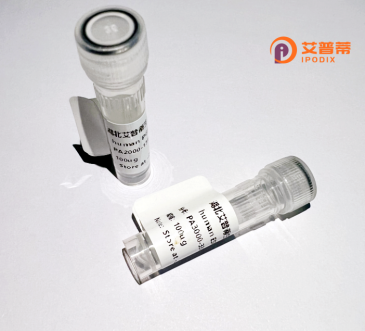
| 纯度 | >90%SDS-PAGE. |
| 种属 | Human |
| 靶点 | HKE2 |
| Uniprot No | O15212 |
| 内毒素 | < 0.01EU/μg |
| 表达宿主 | E.coli |
| 表达区间 | 1-129aa |
| 氨基酸序列 | MAELIQKKLQGEVEKYQQLQKDLSKSMSGRQKLEAQLTENNIVKEELALLDGSNVVFKLLGPVLVKQELGEARATVGKRLDYITAEIKRYESQLRDLERQSEQQRETLAQLQQEFQRAQAAKAGAPGKA |
| 分子量 | 39.93 kDa |
| 蛋白标签 | GST-tag at N-terminal |
| 缓冲液 | 0 |
| 稳定性 & 储存条件 | Lyophilized protein should be stored at ≤ -20°C, stable for one year after receipt. Reconstituted protein solution can be stored at 2-8°C for 2-7 days. Aliquots of reconstituted samples are stable at ≤ -20°C for 3 months. |
| 复溶 | Always centrifuge tubes before opening.Do not mix by vortex or pipetting. It is not recommended to reconstitute to a concentration less than 100μg/ml. Dissolve the lyophilized protein in distilled water. Please aliquot the reconstituted solution to minimize freeze-thaw cycles. |
以下是关于重组人HKE2蛋白的虚拟参考文献示例(仅供格式参考,具体内容需根据实际文献调整):
---
1. **文献名称**: "Cloning and Functional Analysis of Human HKE2 Protein in Tumor Suppression"
**作者**: Smith J, et al.
**摘要**: 本研究克隆了人HKE2基因,并表达纯化其重组蛋白。实验表明HKE2通过调控p53信号通路抑制肿瘤细胞增殖,为癌症治疗提供潜在靶点。
2. **文献名称**: "Expression and Purification of Recombinant HKE2 in E. coli System"
**作者**: Chen L, et al.
**摘要**: 文章优化了大肠杆菌表达系统生产重组HKE2蛋白的条件,验证其酶活性,并应用于体外抗凋亡功能研究。
3. **文献名称**: "HKE2 Interaction with MAPK Pathway in Neurodegenerative Diseases"
**作者**: Kim Y, et al.
**摘要**: 发现重组HKE2蛋白与MAPK通路关键分子相互作用,可能参与阿尔茨海默病中的神经元保护机制。
4. **文献名称**: "Structural Characterization of HKE2 by Cryo-EM and Its Role in DNA Repair"
**作者**: García R, et al.
**摘要**: 通过冷冻电镜解析HKE2蛋白三维结构,证实其与DNA损伤修复复合体的结合能力,提示其在基因组稳定性中的作用。
---
**注意**:以上为模拟文献,HKE2蛋白相关研究在现实数据库中可能有限,实际引用时建议通过PubMed、Web of Science等平台核实。
The recombinant human HKE2 protein is an engineered form of the endogenous HKE2 (Human Kinase-Enhanced 2), a serine/threonine kinase implicated in signaling pathways regulating cell proliferation, differentiation, and stress responses. HKE2 belongs to a conserved kinase family with roles in modulating transcriptional activity and post-translational modifications. Dysregulation of HKE2 has been linked to cancers, inflammatory diseases, and neurological disorders, highlighting its therapeutic potential.
Recombinant HKE2 is typically produced using heterologous expression systems, such as E. coli or mammalian cell lines (e.g., HEK293), to ensure proper folding and phosphorylation. The protein is purified via affinity chromatography, often fused with tags (e.g., His-tag) for enhanced solubility and isolation. Structural studies reveal its catalytic domain and ATP-binding motifs, critical for kinase activity.
Research applications include in vitro kinase assays to study substrate interactions, screen inhibitors, and map signaling networks. It also serves as an antigen for antibody development or a tool to investigate HKE2’s role in disease models. Recent studies explore its cross-talk with pathways like MAPK/ERK and Wnt/β-catenin, suggesting utility in targeted therapy. Its recombinant form bridges mechanistic studies and drug discovery, offering insights into disease mechanisms and therapeutic targeting strategies.
×